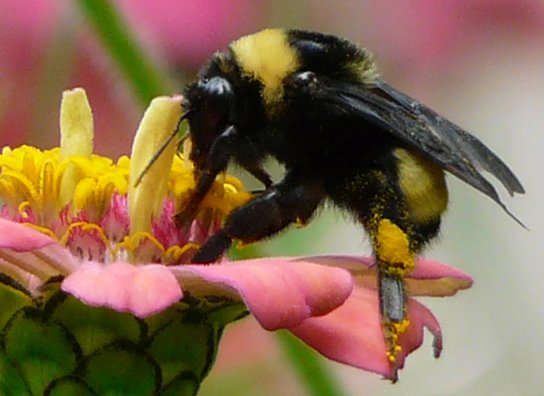Ordinary and otherworldly, California native bees have been on the job in SoCal long before those immigrant honeybees arrived and started hogging the apis spotlight.
A workshop on Saturday, July 9 in Glendale hopes to shine a light on the work and wonders of the native bees offering not just facts and figures, but a chance to go outside and see how bee enthusiasts capture and study bees in the wild.
“I’m hoping we will find a green metallic bee, maybe a bumblebee and small carpenter bees,” says ecologist Michelle Rivers who will be leading the free workshop at Deukmejian Wilderness Park in Glendale from 9-noon. In her United Kingdom homeland, Rivers has worked for the Bumblebee Conservation Trust where she worked to save the great yellow bumblebee.
Rivers moved to Southern California 2 ½ years ago and is enraptured by the diversity of native bees found here. “There are so many more here than back in the United Kingdom and all of them wonderful and important,” she says.

Rivers’ presentation will include an overview of some of the 1,600 different species of native bees in California scattered all over the state. She’ll also talk about what makes a bee a bee and the roles bees play in the bigger ecosystem.
And there will be a discussion about the honeybees which arrived on America soil in the 1700s, brought to the New World for their honey and wax-making abilities. Honeybees didn’t show up in California until about 1853 say bee biologists.
For decades, native bees were mostly forgotten but now, with honeybees experiencing colony collapse syndrome, biologists are researching to see if native bees can be used to pollinate important crops. “Native bees are specialists and work best with certain crops,” explains Rivers citing recent research that includes mason bees and alfalfa crops.
Rivers also hopes her workshop will also calm fears folks have about bees and their pointy parts. “I’ve bothered so many bees in my life and I’ve only been stung once and that was an accident,” she says. FYI: it’s only the females that sting.

In the meantime, cultivating a fancy for bees as well as habitats for them can tip the scale in their favor. “If everyone planted flower or herbs –even on a balcony apartment – that can make a huge difference to bees and other pollinators,” she says. Habitat destruction, loss of wild flowers and areas for nests (some bees nest in the ground and in rotting wood) has contributed to bees scrambling for new territories to feast and reproduce. “Urban environments can accommodate bees and people – we can all get along.”
Native Bees of Southern California takes place 9am – noon, Saturday July 9 at Deukmejian Wilderness Park, 3429 Markridge Road, Glendale. Space is limited. Call Glendale Parks and Open Spaces to reserve a spot at (818) 548-3795. Trail snacks and water provided.
